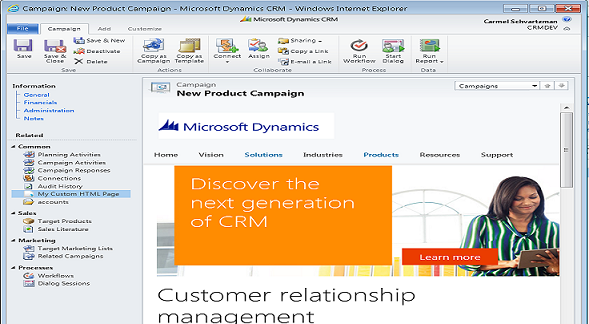by Carmel Schvartzman
- In this walkthrough we will learn How-to develop a custom workflow plug-in .
- First, start VISUAL STUDIO 2010 and create a WF project:
- Next, delete the XAML file,
- IMPORTANT: the class we just created IS NOT PUBLIC: we ough to declare it PUBLIC , elsewhere we'll get a SETUP ERROR at the time of deploying the plug-in to the CRM server:
- We want to create a custom workflow, so we'll inherit from the base class CodeActivity: let's also add the System.Activities using directive:
- The CodeActivity class is ABSTRACT, that means we'll have to implement in this case the method "Execute":
- Delete the "throw new" code. We'll write code of our own:
- Now we'll write our custom activity. First of all, we'll need a CONTEXT that allows us to communicate with the CRM webservices. We'll need the CRM's IOrganizationService, an interface that provides programmatic access to the metadata and data for our CRM Organization. In order to do that, we'll use the IOrganizationServiceFactory, as stated at the MSDN documentation: we'll create it using the GetExtension<......>() method of the context. So write the following code:
However, if after writing the code, you BUILD the solution (F6), you'll face the "Are you missing a using directive or an assembly reference":
That's because we have to tell VS where the CRM specific interfaces that we just wrote are. They are included in the following two assemblies :Microsoft.Xrm.Sdk.dll andMicrosoft.Xrm.Workflow.dll.So add the references to both DLLs (you can find them in the CRM2011 SDK Bin folder : download from here):
Again, while REBUILDING the solution, we get an error message: "...XRM does not exists...":
That's because the target framework default option for a new workflow project is "CLIENT PROFILE": go to PROPERTIES and under "APPLICATION" change the target framework to ".NET Framework 4":
Rebuild the solution. - Now we need to sign the assembly using the "signing" tab of the project's properties:
- Using the IOrganizationServiceFactory, we'll create an instance of the IOrganizationService:
- We'll also need to call another CRM web service, which will allow us to get accurate info about what happened in case of error: it's called ITracingService and again we'll create it using the GetExtension<ITracingService>() method of the context:
Rebuild the solution. We have all we need to use our workflow.
- Now let's add some METADATA: the CRM environment uses this metadata at runtime to link our code to the workflow engine. This way we can also declare a parameter as REQUIRED and even set DEFAULT values just in case the user do not provide them.
Usually, plug-ins need INPUT and OUTPUT parameters. We'll add both of them to our plug-in. For the INPUT parameter, let's add a public InArgument<string> automatic property:Here we declare our "PluginInput" property to be an InArgument of type string, that the CRM workflow engine will know by the name of "PluginInput" , and which its default value is set as "Default Plugin Input". The parameter name will appear in the workflow form assistant, so that the users can map the attribute as anWe can also state that the input parameter will be required, using the following attribute:
[RequiredArgument]Output parameters are declared the same way as input parameters:
And in the code, we use this properties the following way:That means, we GET the input string parameter calling the Get<some type >(context) method of the INPUT property, and SET the OUTPUT parameter using the Set(context, <some object>) method of the output parameter.
- OK, we have our workflow built.
- The next stage is to deploy the DLL wokflow to the Crm server. We need the Plugin Registration Tool that comes with the CRM 2011 SDK, therefore copy that GUI to some directory at the CRM server:
I copied the app to the C:\Plugintool directory.
- Double click the PluginRegistration tool:
- Now, press CONNECT to discover your CRM webservice:
If your CRM server hosts more than one Organization, select the one to wich you developed your plug-in
- Check that the selected CRMService URL is the one you want to deploy your plug-in
- Now press "REGISTER" and next "REGISTER NEW ASSEMBLY":
Now select the assembly you want to deploy:
It's strongly recommended that you set up the ISOLATION MODE to "SANDBOX": the SANDBOX feature gets code executed in an isolated and trusted environment. In the case your plug-in consumes too much server resources, SANDBOX mode will remove it from the event pipeline where you registered your code. Also, the same will be done in case of continuous failing.
IMPORTANT: the assembly can be stored in the DISK or in the DATABASE. At the development stage, it's recommended you store it at the DISK, because there you can also copy the .PDB file used for debugging purposes. Later, when you finished testing your code, YOU MUST DEPLOY IT TO THE DATABASE!! Why? Some reasons are:
- The assemblies registered on database can be included in a solution hosted in sandbox or in CRM ONLINE.
- If your CRM server is load balancing, storing the DLLs in DATABASE will allow CRM to automize the process of updating and deploying changes.
- There's no need to restart the CRM servicesmaking IISRESET on the applicationpool because the update of an assembly will take effect automatically after you press the UPDATE button.
So instead of selecting "DATABASE" select the option "DISK" for now.
That's all
Happy programming :-)
כרמל שוורצמן
כרמל שוורצמן



















 I copied the app to the C:\Plugintool directory.
I copied the app to the C:\Plugintool directory.



 So instead of selecting "DATABASE" select the option "DISK" for now.
So instead of selecting "DATABASE" select the option "DISK" for now.
No comments:
Post a Comment